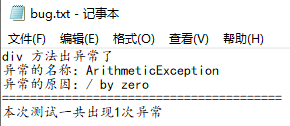注解_案例_简单的测试框架
注解_案例_简单的测试框架
1.以后大多数时候,我们会使用注解,而不是自定义注解
2.注解给谁用?
1.编译器
2.给解析程序用
3.注解不是程序的一部分,可以理解为注解就是一个标签
public class Calculator { //加法 @Check public void add(){ System.out.println("1+0=" + (1+0)); } //减法 @Check public void sub(){ System.out.println("1-0=" + (1-0)); } //乘法 @Check public void mul(){ System.out.println("1*0=" + (1*0)); } //除法 @Check public void div(){ System.out.println("1/0=" + (1/0)); } public void show(){ System.out.println("永无bug..."); } }
@Retention(RetentionPolicy.RUNTIME) @Target(ElementType.METHOD) public @interface Check { }
/* 简单的测试框架 当主方法执行后,会自动自行被检测的所有方法(加了Check注解的方法),判断方法是否有异常,记录到文件中 */ public class TestCheck { public static void main(String[] args) throws IOException { //1创建计算器对象 Calculator c = new Calculator(); //2.获取字节码文件对象 Class cls = c.getClass(); //获取所有方法 Method[] methods = cls.getMethods(); //出现异常的次数 int number = 0; BufferedWriter bw = new BufferedWriter(new FileWriter("F:\\bug.txt")); for (Method method : methods) { //判断方法上是否有Check注解 if (method.isAnnotationPresent(Check.class)){ //有执行 try { method.invoke(c); } catch (Exception e) { //捕获异常 //记录到文件中 number++; bw.write(method.getName() + " 方法出异常了"); bw.newLine(); bw.write("异常的名称:"+e.getCause().getClass().getSimpleName()); bw.newLine(); bw.write("异常的原因:"+e.getCause().getMessage()); bw.newLine(); bw.write("========================================"); bw.newLine(); } } } bw.write("本次测试一共出现"+number+"次异常"); bw.flush(); bw.close(); } }









【推荐】国内首个AI IDE,深度理解中文开发场景,立即下载体验Trae
【推荐】编程新体验,更懂你的AI,立即体验豆包MarsCode编程助手
【推荐】抖音旗下AI助手豆包,你的智能百科全书,全免费不限次数
【推荐】轻量又高性能的 SSH 工具 IShell:AI 加持,快人一步
· Manus重磅发布:全球首款通用AI代理技术深度解析与实战指南
· 被坑几百块钱后,我竟然真的恢复了删除的微信聊天记录!
· 没有Manus邀请码?试试免邀请码的MGX或者开源的OpenManus吧
· 园子的第一款AI主题卫衣上架——"HELLO! HOW CAN I ASSIST YOU TODAY
· 【自荐】一款简洁、开源的在线白板工具 Drawnix